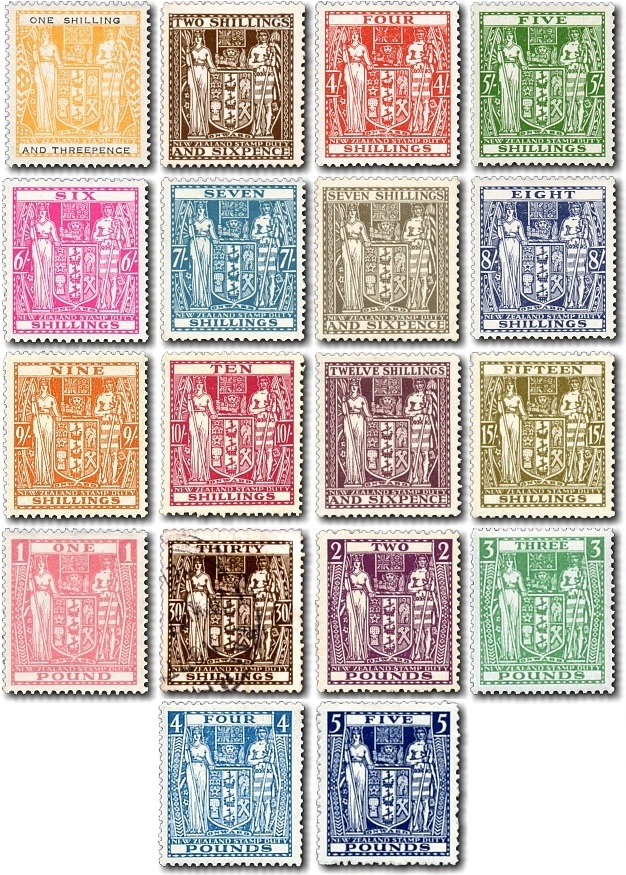
1931 Arms Postal Fiscals
«previous next»

| Cat. | Mint Unhinged | Mint Hinged | Fine Used | |||||
| 1/3 | Yellow (Simplified) | 44a | $17.00 | $9.00 | $4.50 | |||
| (i) Lemon Yellow (1931 only) | 44a1 | $108.00 | $70.20 | $119.00 | ||||
| (ii) Orange Yellow (1931 on) | 44a2 | $32.40 | $25.20 | $5.10 | ||||
| (iii) Orange Yellow / Black (from 1955 on) | 44a3 | $19.80 | $10.80 | $10.80 | ||||
| (iv) Orange Yellow / Blue (1956 colour error) | 44a4 | $43.20 | $34.20 | $31.50 | ||||
| 2/6 | Brown | 44b | $52.20 | $28.80 | $2.00 | |||
| 4/- | Red | 44c | $55.80 | $32.40 | $5.40 | |||
| 5/- | Green | 44d | $61.20 | $43.20 | $5.40 | |||
| 6/- | Pink | 44e | $99.00 | $61.20 | $14.40 | |||
| 7/- | Blue | 44f | $117.00 | $68.00 | $64.80 | |||
| 7/6 | Grey | 44g | $229.50 | $135.00 | $189.00 | |||
| 8/- | Blue | 44h | $189.00 | $126.00 | $64.80 | |||
| 9/- | Orange | 44i | $189.00 | $117.00 | $81.00 | |||
| 10/- | Red | 44j | $94.50 | $55.80 | $16.20 | |||
| 12/6 | Claret (from 1935 on) | 44k | $792.00 | $468.00 | $450.00 | |||
| 15/- | Olive | 44l | $234.00 | $144.00 | $72.00 | |||
| £1 | Pink | 44m | $144.00 | $79.90 | $19.80 | |||
| 30/- | Brown | 44n | $900.00 | $558.00 | $315.00 | |||
| £2 | Violet | 44o | $405.00 | $270.00 | $108.00 | |||
| £3 | Green | 44p | $495.00 | $315.00 | $207.00 | |||
| £4 | Blue | 44q | $576.00 | $297.00 | $405.00 | |||
| £5 | Blue | 44r | $774.00 | $522.00 | $252.00 | |||
| Set of 18 | 44s | $5,153.00 | $3,163.80 | $2,162.50 | ||||

The 1/3 stamp was first issued in a pale lemon yellow colour (44a1) which made the design very hard to see, and so was reissued in a darker orange yellow (44a2). From 1955, black text was added to make the stamp easier to read (44a3) and in 1956 this was accidentally printed in blue ink (44a4).
Although all values were authorised for postal use, several values were not typically used for postage. For simplicity, this catalogue lists only those stamps that were postally used on a regular basis.
In two situations, the Arms stamp design printed in red but without any value in the top and bottom borders was surcharged for use as a provisional postage-only stamp. These stamps are listed separately in this catalogue under 1950 Arms Provisional and 1964 Provisional.
Fiscal stamps were intended primarily for tax gathering by government departments in New Zealand. They were attached to documents and cancelled as proof of payment when taxes, import duties or other legal fees were paid. These were typically large payments and so the stamps have correspondingly high face values. From 1882 these stamps could also be sold by the post office to cover postage costs. These postal cancellations are rare because very few parcels cost such large amounts to send around the country - this is why they are worth considerably more than fiscal cancellations. Fiscally cancelled stamps do have value however and people do collect them.
Distinguishing postally and fiscally used stamps can be quite tricky. All stamps with pen cancellations, punched holes or embossing are fiscally used. Stamps should be inspected under ultraviolet light to see if a fiscal pen cancellation has been removed. Embossed designs were frequently employed on documents and attempts to iron these out have been noted in the past. If the stamps have been postmarked, fiscal cancellations give the region while postal cancellations give the individual post office where the mail was cancelled. Simple circular date stamps with no region or place, and circular 'Stamp Duties Dept' or 'Inland Revenue' date stamps on Arms issues are fiscal cancellations, and if only the outer ring of the cancellation is visible on the stamp it is safest to assume you have a fiscal cancellation.
Bibliography
The Postage Stamps of New Zealand (Volume I)
Edited by R. J. G. Collins and H. T. M. Fathers B.A. B.Sc.
Published 1938 by The Philatelic Society of New Zealand Incorporated
Pages 513 - 515
The Postage Stamps of New Zealand Volume II
Edited by R. J. G. Collins FRPSNZ and C. W. Watts FRPSNZ
Published 1950 by The Royal Philatelic Society of New Zealand Incorporated
Pages 204 - 208, 207 - 208
The Postage Stamps of New Zealand Volume IV
Edited by R. J. G. Collins FRPSNZ and C.W. Watts FRPSNZ
Published 1960 by The Royal Philatelic Society of New Zealand Incorporated
Pages 396 - 397
The Postage Stamps of New Zealand Volume VI
Edited by D. E. G. Naish FRPSNZ and K. J. McNaught FRPSNZ FRPSL
Publsihed 1975 by The Royal Philatelic Society of New Zealand Incorporated
Pages 292 - 293
Catalogue ·
1930 ·
1931 ·
1932 ·
Definitives ·
Postal Fiscal (Arms)
Order Form · Currency Converter · Privacy Policy
What to Expect · Contact Us · Links
Order Form · Currency Converter · Privacy Policy
What to Expect · Contact Us · Links
Wishing you a Merry Christmas and a Happy and Prosperous New Year
This page was last updated on 27 Dec 2025
All content and images copyright © 2008 - 2025 StampsNZ
This page was last updated on 27 Dec 2025
All content and images copyright © 2008 - 2025 StampsNZ